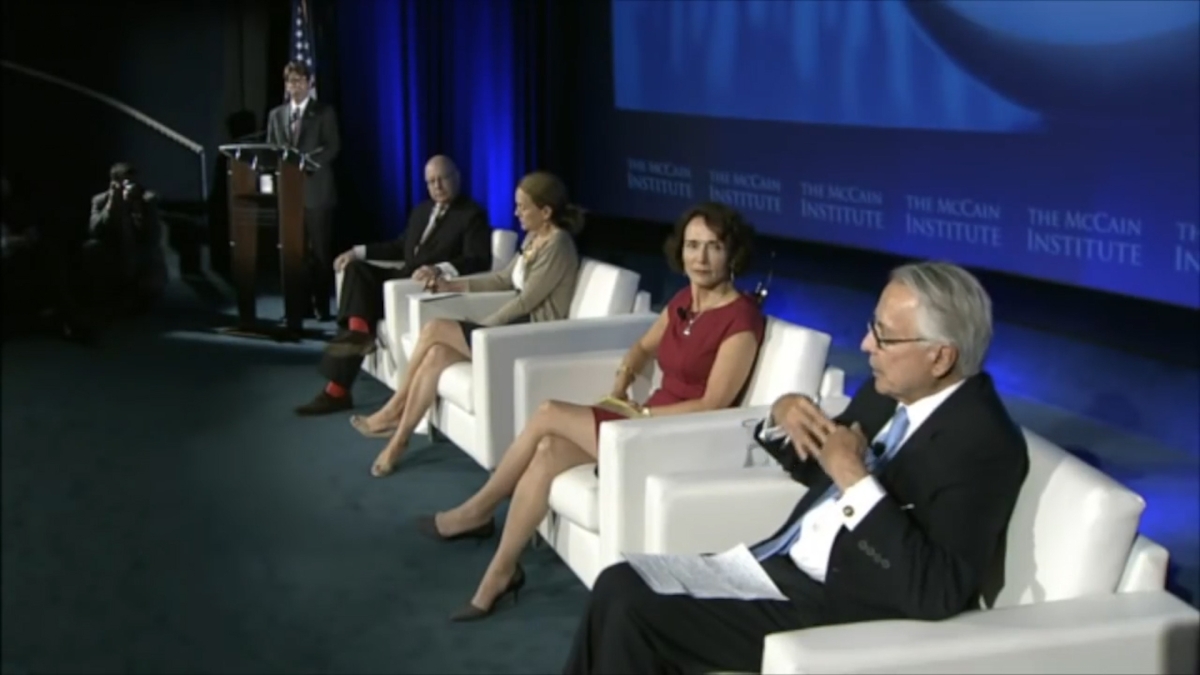ASU Insight: Should the United States be the World’s Policeman?

Should the United States be the World’s policeman?
On Thursday, September 10, The McCain Institute for International Leadership at Arizona State University hosted the debate at the Burke Theatre at the Navy Memorial, in Washington. The question brought forward was: “Should the United States be the World’s Policeman?”
The debate centered upon the relative strengths and weaknesses of U.S. leadership in the world, and whether U.S. decision makers should use the significant military, economic and diplomatic resources at their disposal to continue shaping and arbitrating events in the international system.
THE DEBATERS
Pro
Julianne Smith, Senior Fellow and Director of Strategy Statecraft Program, Center for New American Security
Tom Donnelly, Resident Fellow and Co-Director of the Marilyn Ware Centre for Security Studies
Con
Richard Burt, Chairman of the National Interest Advisory Board
Elizabeth Cobbs, Melbern Glasscock Chair, Texas A&M University
Moderating the debate
Jon Decker, White House Correspondent at Fox News Radio
THE KEY ARGUMENTS
Arguments in favor of the United States being the world’s policeman:
- Historical evidence suggests that the United States policing of the world has been an unprecedented success. Since WWII U.S. leadership has brought prosperity and stability to its shores and those of its allies; it was instrumental in rebuilding Europe and containing the Soviet threat throughout the second half of the 20th century. This points to a compelling moral necessity for U.S. leadership.
- If not the US, then who? The UN and other international organizations have been a largely ineffectual in establishing stability and security. There is no viable alternative without U.S. policing.
- It is in the national interest to preserve the liberal economic and political order that has been built since 1945. The United States should remain in a global leadership role to prevent emerging threats, especially China and Russia, from challenging it.
Arguments against the United States being the world's policeman:
- The United States must adapt to changing contexts and stop states from freeriding under its security umbrella. In the post-WWII context there was a clear need for U.S. leadership; it was the only great power with the material capacity to reconstruct a devastated Europe and challenge the imperial visions of the Soviet Union. In 1947 the United States had to ‘jump to the rescue’ and ‘act as umpire’. Today, however, the picture is very different. There are more democracies and fewer conflicts that ever before. The case for U.S. leadership has diminished and regions should assume responsibility for their own security.
- The United States has suffered from the overextension of its resources and capital. It must begin to scale down its engagement and prioritize between its core and periphery interests.
- Democracy promotion is a quandary that the United States has stumbled in too often. Since the Cold War, US foreign policy has dealt poorly with civil wars, failed states and peace building. The ability of the United States to arbitrate international events effectively has slipped.
- The doctrine of liberal intervention is fruitless. Instead of prioritizing hard power, U.S. decision makers should favor diplomacy and soft power. The United States should no longer coerce but persuade.
RECOMMENDATIONS
Julianne Smith highlighted that isolationism is a cyclical occurrence in U.S. foreign policy, and that, ultimately, having the United States in a leadership role is a global interest. Ms. Smith concluded that future policy should reinforce the United States’ unique leadership role. In terms of soft and hard power, the United States should continue to bring innovation, capacity, drive, risk-taking and coalition building.
Thomas Donnelly advocated safeguarding the U.S.-lead liberal order and the values it entails. Mr. Donnelly argued that weakening U.S. leadership is a choice that will compromise this system.
Richard Burt did not challenge the notion of U.S. leadership itself. Instead, he argued that future policy should adhere to a tightly defined national interest. All policy should strictly reflect these national priorities. Ambassador Burt made the point that military force should be considered in conjunction with economic and political priorities.
Elizabeth Cobbs said the United States should aim to be part of a system in which it is not the only pillar guaranteeing order. Dr. Cobbs called for U.S. leadership to share the burden of spreading peace and security with its regional partners.

